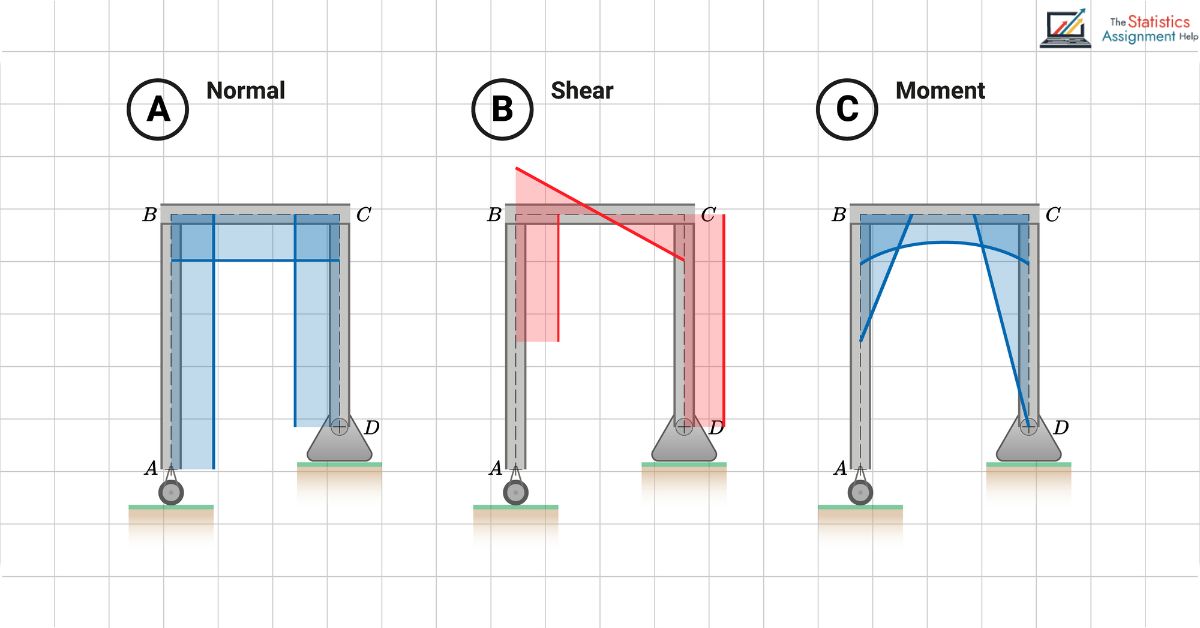
- 13th Oct 2025
- 06:03 am
As an engineering student tackling statics coursework, you've likely encountered frame analysis problems that seem overwhelming at first glance. Whether you're working on homework assignments late at night or preparing for an upcoming exam, understanding the fundamental differences between rigid and non-rigid structures is crucial for success in your structural analysis course. This comprehensive guide will help you master frame analysis concepts and provide insights into when you might need additional tutoring help or assignment assistance.
What is Frame Analysis and Why Does It Matter?
Frame analysis is a critical component of structural engineering that involves evaluating how forces distribute throughout interconnected members in a structure. Unlike simple beam problems or truss analysis that you may have already studied, frame analysis deals with structures where members can resist bending moments, shear forces, and axial forces simultaneously.
When you're working through your statics homework, you'll encounter frames in bridges, building frameworks, mechanical linkages, and countless other real-world applications. Understanding how these structures behave under load is essential not just for passing your course, but for becoming a competent engineer who can design safe, efficient structures.
Rigid vs. Non-Rigid Structures: The Foundation of Frame Analysis
Understanding Rigid Structures
Rigid structures, also called rigid frames, are systems where the connections between members prevent relative rotation. Imagine the corner of a building frame where a column meets a beam—in a rigid frame, these members are welded or bolted together so firmly that the angle between them cannot change when loads are applied.
Key characteristics of rigid structures:
- Joints are fixed and cannot rotate relative to each member
- Members can resist moments, shear forces, and axial forces
- The structure maintains its shape under load without requiring external bracing
- More complex to analyze but often more efficient in material usage
When you're working on assignment problems involving rigid frames, you'll need to consider moment equilibrium at every joint. This is where many students struggle and seek tutoring help, as the equations become more complex than basic statics problems.
Understanding Non-Rigid Structures
Non-rigid structures, often called pinned or simple frames, have connections that allow rotation at joints. Think of a door hinge—it allows rotation around a single axis. In frame analysis, pin connections behave similarly.
Key characteristics of non-rigid structures:
- Joints are pinned and allow free rotation
- Members primarily resist axial forces (tension or compression)
- Cannot resist bending moments at pinned connections
- Simpler to analyze but may require more members or external support
- Similar to truss analysis in many ways
Understanding when a frame is rigid versus non-rigid is crucial for setting up your homework problems correctly. Many students find themselves stuck because they've misidentified the type of structure they're analyzing—this is a common reason students reach out for assignment help.
Step-by-Step Approach to Frame Analysis Problems
Step 1: Identify the Type of Frame
Before diving into calculations, carefully examine your homework problem to determine whether you're dealing with a rigid or non-rigid frame. Look for these indicators:
- Moment connections suggest rigid frames
- Pin symbols at joints indicate non-rigid connections
- Problem statement clues like "welded connections" or "pinned joints"
If you're uncertain about the connection types, this is an excellent time to seek tutoring help before proceeding with the wrong approach.
Step 2: Draw a Complete Free Body Diagram
Creating accurate free body diagrams is fundamental to successful frame analysis. For your statics assignments, you'll need to:
- Identify all external loads, reactions, and moments
- Show internal forces at any points where you "cut" the frame
- Label all known and unknown forces clearly
- Include dimensions and angles accurately
Many students underestimate the importance of thorough free body diagrams. When professors or tutors help students with homework, they often find that errors originate from incomplete or inaccurate diagrams rather than calculation mistakes.
Step 3: Apply Equilibrium Equations
For rigid frames, you'll apply the three equilibrium equations to the entire structure and often to individual members:
- ΣFx = 0 (sum of horizontal forces equals zero)
- ΣFy = 0 (sum of vertical forces equals zero)
- ΣM = 0 (sum of moments equals zero)
For non-rigid frames with pin connections, remember that moments cannot be transmitted through pins, which simplifies your analysis but requires careful attention to which equations apply where.
Step 4: Solve Systematically
When working through assignment problems, adopt a systematic approach:
- Start with the structure as a whole to find external reactions
- Analyze individual members or joints methodically
- Check your work by verifying equilibrium at multiple points
- Use symmetry when possible to reduce calculations
Common Challenges Students Face in Frame Analysis
Challenge 1: Determining Support Reactions
Many students struggle with identifying all support reactions, especially when dealing with fixed supports that provide both force and moment reactions. If you find yourself repeatedly stuck on this step, consider seeking homework help from experienced tutors who can guide you through the process of identifying constraint conditions.
Challenge 2: Handling Multiple Connected Members
When your assignment involves frames with numerous connected members, tracking all the internal forces becomes complex. Creating organized calculation sheets and using consistent notation helps prevent errors. This is where assignment help services can provide structured approaches that improve your problem-solving efficiency.
Challenge 3: Sign Conventions and Direction Assumptions
Maintaining consistent sign conventions throughout your analysis is critical. Many homework errors stem from switching between different conventions mid-problem. Establishing and sticking to a clear convention—such as tension positive, compression negative—will serve you well throughout your engineering education.
Challenge 4: 3D Frame Analysis
While most introductory statics courses focus on 2D frames, you may encounter 3D frame problems in advanced assignments. These require comfort with vector notation and spatial reasoning. Don't hesitate to seek tutoring help early when transitioning to three-dimensional analysis, as building strong foundational understanding prevents future struggles.
Practical Tips for Mastering Frame Analysis Homework
- Start early on assignments: Frame analysis problems take time. Beginning your homework well before the deadline allows opportunity to seek help if needed and avoid rushed, error-prone work.
- Practice with varied problems: Your textbook likely contains numerous practice problems. Working through different configurations builds intuition about how frames behave under various loading conditions.
- Form study groups: Collaborating with classmates on homework (while ensuring you understand the concepts yourself) provides exposure to different problem-solving approaches.
- Use available resources: Your university likely offers tutoring services, office hours, and online resources. Professional assignment help services like The Statistics Assignment Help can provide expert guidance when you're truly stuck.
- Verify your answers: Always perform a sanity check on your results. Do the reaction forces balance the applied loads? Are the magnitudes reasonable? Does the structure's deformation make physical sense?
When to Seek Professional Assignment Help
While working through homework independently builds crucial skills, there are times when professional tutoring help becomes invaluable:
- Persistent confusion: If you've attempted problems multiple times without understanding where you're going wrong
- Time constraints: When deadlines approach and you need efficient, accurate guidance
- Exam preparation: Getting personalized tutoring to address your specific weaknesses before major tests
- Complex projects: Large assignments involving multiple analysis techniques may benefit from expert review
Professional services like The Statistics Assignment Help offer specialized tutoring in statics and structural analysis, providing step-by-step explanations that help you understand not just the solution, but the underlying principles.
Building Long-Term Understanding
Frame analysis skills extend far beyond your current homework assignments. The concepts you're learning now form the foundation for advanced courses in structural engineering, mechanical design, and finite element analysis. Investing time in truly understanding rigid and non-rigid behavior, rather than just memorizing solution procedures, pays dividends throughout your engineering career.
Consider frame analysis homework as an opportunity to develop problem-solving skills applicable to real-world engineering challenges. Every assignment you complete, whether independently or with tutoring assistance, strengthens your analytical abilities and engineering intuition.
Conclusion
Mastering frame analysis requires understanding the fundamental differences between rigid and non-rigid structures, developing systematic problem-solving approaches, and knowing when to seek additional help. As you work through your statics coursework, remember that struggling with complex concepts is normal—every successful engineer has been exactly where you are now.
Whether you're tackling homework independently, attending tutoring sessions, or seeking assignment help from professional services, the key is maintaining focus on understanding core principles rather than just getting correct answers. Frame analysis might seem daunting now, but with consistent practice and appropriate support when needed, you'll develop the confidence and competence to handle increasingly complex structural problems.
For students needing additional support with frame analysis or any statics concepts, The Statistics Assignment Help provides expert tutoring and comprehensive assignment assistance tailored to your specific learning needs. Remember, seeking help isn't a sign of weakness—it's a strategic approach to mastering challenging engineering concepts efficiently and effectively.








